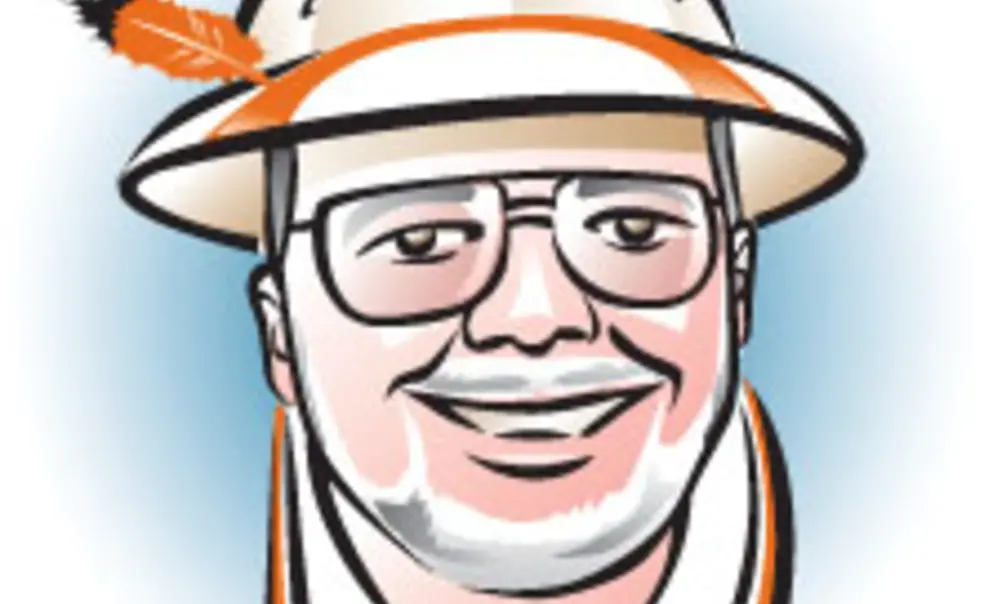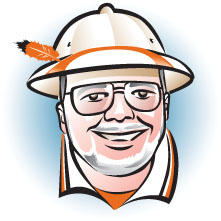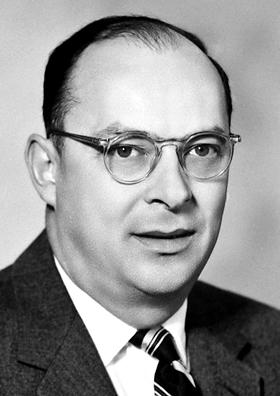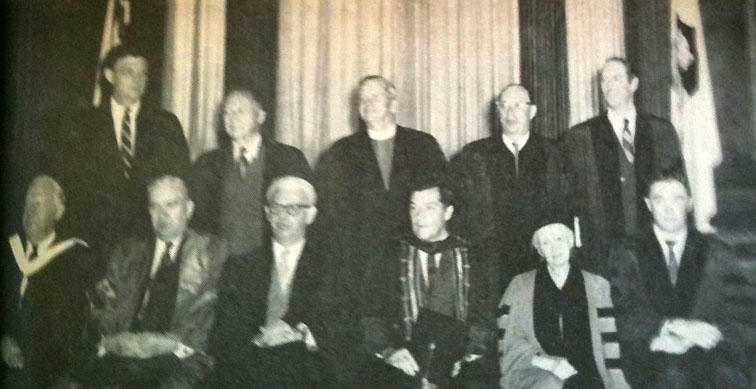“Lucky Accidents, Great Discoveries and the Prepared Mind”
— Prof. Hubert Alyea ’24’s signature lecture
Did you ever get the feeling the mechanisms of the universe (our four dimensions of it, anyway) are pushing you toward some inexorable end? Well, yes, I suppose cleaning out the litter box under imminent threat of divorce is an example, but I was thinking along slightly subtler lines. Last summer, while interviewing professor emeritus Harold Kuhn *50 for the University Archives, we spoke about his colleague, Professor Albert Tucker *32, and his monumental historical project documenting the Princeton math department in the 1930s, when Tucker was a grad student a generation before Kuhn arrived. Then, in December, writing about Dick Kazmaier ’52’s Heisman Trophy surprisingly drew me to the Nobel Prize and the striking range of Princeton alumni and faculty who have been honored (Toni Morrison and John Nash *50 in consecutive years, for heaven’s sake). And then researching famous Princetonians for the World’s Only Princetoniana Committee led not only to ruminating on the nature of the graduate school, but smack into the Nobel list again, where one particular name always beckons – John Bardeen *36, the only person on the planet to receive the Nobel in physics twice. So I checked Tucker’s project notes to see if Bardeen had sat for an interview; in fact, he had been interview No. 1. Clearly, we are meant to discuss this, or I’ll be seeing Bardeen’s silhouette on my pillow and my French toast next. So please humor me, and I promise to address tennis or something next time.
Among all the great alumni I’ve been studying up on, Bardeen generally is not very closely identified with Princeton; he’s an icon principally at the University of Illinois at Urbana-Champaign. That’s where the school’s engineering quadrangle is named for him and where he spent the last 40 years of his life teaching engineering, physics, and about anything else he wanted to, while collecting his Nobels in 1956 and 1972. Anathema to stereotypically mad scientists everywhere, he leaned toward golf, picnics, and cookouts for the neighbors. He loved his hamburger buns toasted, and always asked if the guests wanted them that way. But as he said in his 1984 interview with Tucker, “I consider the period at Princeton the two most influential years I spent anywhere,” where he first worked with solid-state physics (crucial to his Nobels for the transistor and for superconductivity) and got up to speed on quantum mechanics. Which means we really must discuss Eugene Wigner and afternoon tea.
As the Depression got up (down?) and running in 1930 and the mood in Germany, where quantum physics recently had originated, got darker, restlessness set in among the great scientific minds of Europe; so American universities made their moves. In Princeton’s case, this centered around the math department, which had been built up carefully by the legendary Henry Burchard Fine 1880, and after his death in 1928 by his successor (groomed since his appointment as a Wilson Preceptor Guy in 1905), Luther P. Eisenhart. A $3 million fund for the sciences had been assembled, a new home built in 1931 – the palatial original Fine (now Jones) Hall, memorialized in the Faculty Song as “a country club for math where you can even take a bath” – and the serendipitous funding/founding of the brand-new Institute for Advanced Study seemed to open the field to undreamed-of possibilities. Among Eisenhart’s first moves was reaching out to Berlin for both Wigner, already a noted expert in quantum theory who hobnobbed with folks like Planck, Heisenberg, and Einstein, and the polymath John von Neumann, whose stunning mathematical insights essentially made him an instant expert in anything he looked at, including quantum mechanics, statistics, nuclear fission, digital computing, hydrodynamics, and game theory, which he essentially invented with economics professor Oskar Morgenstern, a German refugee (Wigner and von Neumann were Hungarian). By 1933, the Institute had hired its first four professors for its department of mathematics – three Princeton faculty including von Neumann, plus Einstein. In addition to the new math hires from the Continent and the various grad students, they all occupied Fine Hall, since the Institute had no physical home yet. And every day at relatively (sorry about the physics joke) 4:00 p.m., they would all wander in to the Fine Hall faculty lounge for tea (and games – this is where the Go scenes in A Beautiful Mind actually came from). It takes no skill to imagine the depth of conversation, especially in an era when cutting-edge math and physics were intertwined – a good chunk of the physics department would wander over to speak with Wigner, von Neumann, or Einstein, who were theoretically (sorry again) mathematicians, and even the students couldn’t tell who was who.
Bardeen tells about one grad-student friend who studied with him for two years; only when they took their orals did Bardeen find his friend was in the physics department. And the eventual results were intermixed, too; not only did “mathematicians” Wigner and Bardeen win Nobels in physics, but physics students Robert Hofstadter *38 and Edwin McMillan *33 (in chemistry!) did too, Bob Dicke ’39 should have won one for his theory of cosmic-background radiation, and von Neumann should have won in economics for his game-theory work. Just for fun, the enigmatic Alan Turing *38, the father of computer science whose centennial Princeton will be celebrating in May, was doing his foundational work in ordinal logic in his dissertation for Professor Alonzo Church. These people all worked within a hundred yards of each other, and sipped tea together every afternoon.
In 1933, Bardeen, working at Gulf Oil in Pittsburgh after having taken every worthwhile math and engineering course offered at Wisconsin (where his father was dean of the medical school), saw what was coming together in Princeton and felt his academic side bubbling to the surface. Abandoning his work in geophysics, he applied to the Princeton math department, but nowhere else; if he’d been turned down, he might never have seen enough cutting-edge physics to even approach his Nobel-winning work at Bell Labs years later. As he puts it in his interview, “if they had not let me in, I probably would not have left Gulf.” He spent only one full year on campus, then returned fitfully to finish his doctorate in mathematical physics in 1936, but his time working on his dissertation with Wigner (who was hot on solid-state physics at the time) and at tea with the assembled theorists showed his mind to be first-rate and his gifts in materials science to be powerful. Wigner stayed on at Princeton to teach generations of students until 1971, and was highly productive long after that. His groundbreaking work in the symmetry of quantum mechanics earned him the physics Nobel in 1963, which shocked him; much of his finest work was actually in pure mathematics.
Eleven years after Bardeen left Princeton, and after Wigner and many others detoured to complete the portentous Manhattan Project during World War II (Bardeen turned down an offer to join them), the next generation of brilliant minds showed up at Fine Hall: Nash, Kuhn, David Gale *49, John Tate *50, Serge Lang *51, and John Milnor ’51*54, among others, to take their place at tea, to wander over to the Institute to speak with von Neumann, to work with Tucker, Ralph Fox *39, John Tukey *39, Emil Artin, and Solomon Lefschetz, now the chairman of the department. In 1951, Bardeen had a falling out with his colleagues at Bell Labs after only six years there – including the invention of the transistor that won them the Nobel – and left for an offer at Illinois. After only six years there (you want your burger medium-rare, correct?), he had developed the BCS theory of superconductivity that won him his second prize.
Now we would all like to think of history as an orderly, if not inevitable process, but there is always something to be learned from the Law of Unintended Consequences (oxymoron alert), as so memorably pointed out by the unique Professor Hubert Alyea ’24 *28 in his paean to happenstance and opportunity. Only a particular moment of European unrest, coupled with the recruiting efforts of someone like Eisenhart or the new Institute, could have conspired to bring together the cast of “mathematicians” that stirred Bardeen’s creative juices and brought the son of Wisconsin and Pittsburgh to Fine Hall, then sent him out into the cutting edge of solid state physics, instead of perhaps the Texas oil fields. We likely would still, of course, have plasma picture screens and MRIs, but I doubt we’d have a double Nobelist in physics to look up to, or perhaps a spiffy quad with toasty buns in Urbana. And who then might have been Albert Tucker’s interview No. 1?















No responses yet